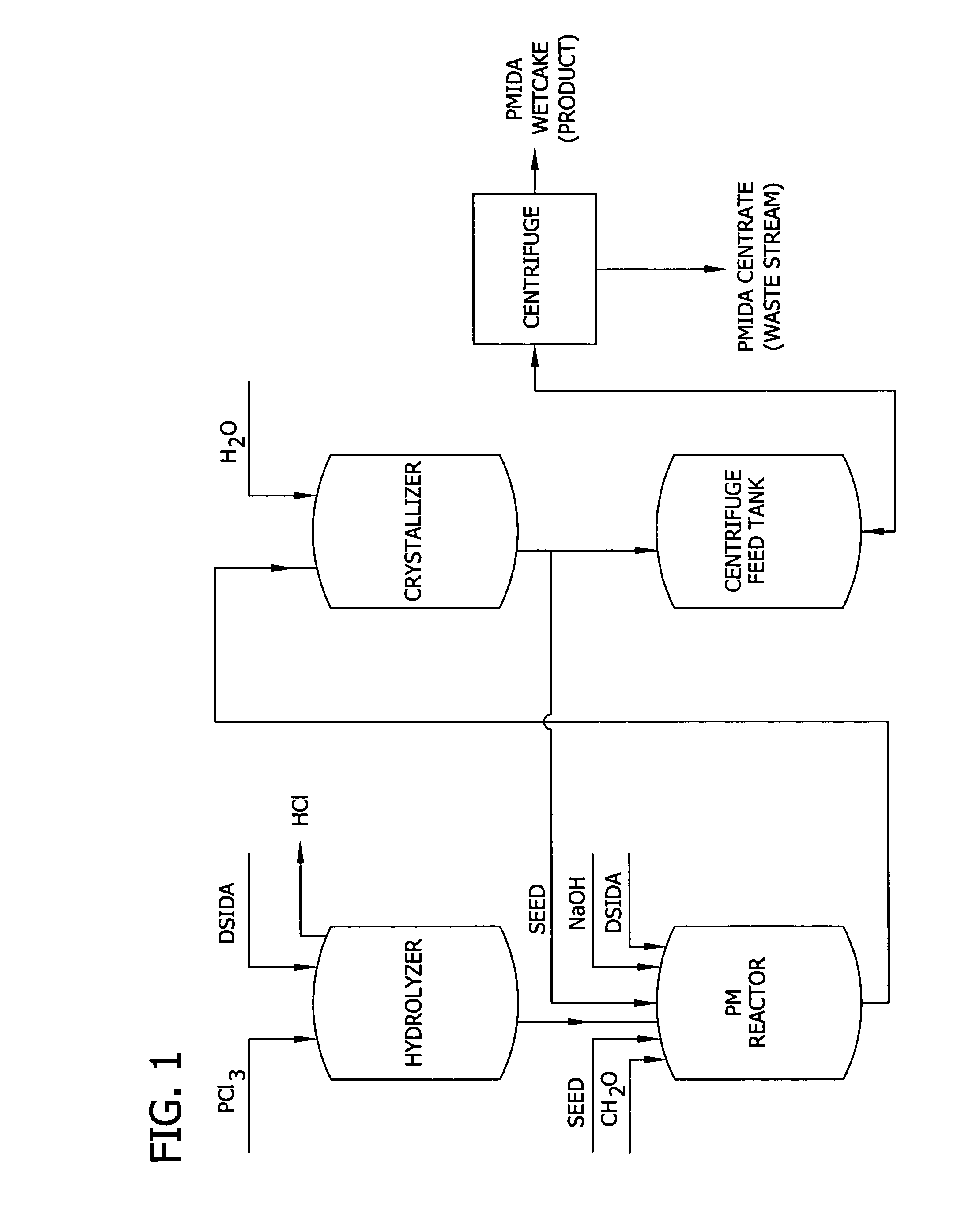Altering the crystal size distribution of N-(phosphonomethyl) iminodiacetic acid for improved filtration and product quality
a technology crystal size distribution, which is applied in the field of improving the process of the preparation of n-(phosphonomethyl) iminodiacetic acid product, can solve the problems of pmida to “crash” from solution, inefficient use of process equipment, and long processing time. achieve the effect of improving permeability and filtration ra
- Summary
- Abstract
- Description
- Claims
- Application Information
AI Technical Summary
Benefits of technology
Problems solved by technology
Method used
Image
Examples
example 3
[0137]A first set of comparative PMIDA experiments were done without seeding to establish a baseline from which the effects of PMIDA seeding could be evaluated. The experiments were done using 43% formalin feed as the formaldehyde source. One preparation used a stepped-formalin feed. The experiments were done to enable evaluation of the impact of seeding, to determine the impact of NMG on overall impurity partitioning, and to evaluate the effect of stepped-formalin feed on impurity partitioning.
[0138]PM run 1 evaluated the effect of elevated NMG levels on glyphosine partitioning and established a reference for comparing varying types of seeding experiments. After the hydrolyzer step was completed, 0.56% on a final batch weight basis of NMG was added to the reactor. Total feed times were 55 minutes for DSIDA1 and 60 minutes for formalin. PMIDA appeared to crash from solution after about 63% of the total formalin had been added. Table 3A gives the results of ML sample analysis for sam...
example 4
[0153]A second set of comparative PMIDA experiments was done without seeding to establish a baseline from which the effects of PMIDA seeding could be evaluated. The experiments were done using DSIDA2 and 43% formalin feed, and the formalin feed was stepped down. The feed DSIDA2 and formalin feed times for run 9 were 65 and 70 minutes, respectively, and for run 10 were 60 and 65 minutes, respectively. In run 9 the formalin feed rate was stepped down, or dropped by about one third, after about 33% of the total formalin had been added while in run 10 the formalin feed rate was stepped down, or dropped by about one third, after about 38.5% had been added. Crystallization onset was observed at about 61% of total formalin addition in run 9 and at about 67% of total formalin addition in run 10. The results are reported in Tables 4A to C below.
[0154]
TABLE 4APM run 9 ML composition profile% formalinPMIDANMGglyphosineadded(wt %)(ppm)wt %24%14.938550.2241%18.245270.2449%20.638120.3256%22.34794...
example 5
[0161]Another set of comparative PMIDA experiments, PM runs 14 and 19, were done without seeding to establish a baseline from which the effects of PMIDA seeding could be evaluated. The experiments were done using DSIDA1 and 37% formalin feed as the formaldehyde source. The formalin feed was not stepped down. Total feed times were 55 minutes for DSIDA1 and 60 minutes for formalin. Crystallizing event times for the two runs were different due to problems encountered in the run 14 formalin addition. Crystallization began after 50% formalin addition in run 14 and after 70% addition in run 19. The results are reported in Tables 5A and 5B below.
[0162]
TABLE 5APMIDA profile of PM run 14 ML and slurry% formalinML PMIDASlurry PMIDAadded(wt %)(wt %)3917.114.94618.716.85220.218.26021.319.66813.921.07410.422.0967.023.6
[0163]
TABLE 5BglyphosineNMGglyphosineNMGpartitioningpartitioningComponent(wt %)(ppm)(%)(%)Run 14 ML0.183719——Run 14 Wash0.11166936.328.1Run 14 Dried Cake0.446031——Run 19 ML0.264215...
PUM
| Property | Measurement | Unit |
|---|---|---|
| temperature | aaaaa | aaaaa |
| molar ratio | aaaaa | aaaaa |
| molar ratio | aaaaa | aaaaa |
Abstract
Description
Claims
Application Information
 Login to View More
Login to View More - R&D
- Intellectual Property
- Life Sciences
- Materials
- Tech Scout
- Unparalleled Data Quality
- Higher Quality Content
- 60% Fewer Hallucinations
Browse by: Latest US Patents, China's latest patents, Technical Efficacy Thesaurus, Application Domain, Technology Topic, Popular Technical Reports.
© 2025 PatSnap. All rights reserved.Legal|Privacy policy|Modern Slavery Act Transparency Statement|Sitemap|About US| Contact US: help@patsnap.com



